#and then hes depowered for failing once. you died a hero and you got to keep your title but for someone who at the end of the day
Explore tagged Tumblr posts
Text
I remembered that a few years ago an ex-mutual made a post once of all the death that should have happened pre-TYBW with one of them being Yumichika dying in the first Arrancar wave with Grimmjow's sidekicks.
There are many reasons pre-TYBW deaths don't work. Here are a few:
One, It makes the rest of the story can of predictive. The reasons why Luppi's attack and Ulquiorra's number reveal were so devastating was because of our heroes previous victories. Urahara's rescue wouldn't have hurt as bad if someone died during the first round. It would be kind of stupid of you constantly kill of characters to up the stakes cause all it does it make the audience play the red shirt version of Where's Waldo.
If you kill off characters on the regular, you need to have moments of hope where at least someone survives or else it's 90% grimdark with a somewhat okay ending. It's an extremely tricky balance to pull, but it still needs to be balanced for a reason.
Two, the timing just doesn't work when including the bigger picture. Most of the characters that were mentioned on the kill list (that I am not going to share cause I'd be doxxing OP's account and tumblr is full of freaks who enjoy harassing people) were killed off before they can truly be likable enough to give a shit if they died. If you kill off Yumichika during the first wave, you'll rob him of his moment with Ikkaku where we see him for the firs time outside of his bitchy persona. If you kill off Omaeda during any of the two battles, you don't get to see him risk it all to save his little sister and other small moments of humanity comedy characters desperately need. And I don't think I need to mention who murdering any of Ichigo's friends is so unnecessary.
TYBW deaths and last hurrahs hit hard because we already got to know these characters as people rather than archetypes. We saw them succeed, cry, break down and rise again which is why watching them fail again thanks to something that's completely out of their control hurts so much. Robbing any of them of the little moments they get to have in a manga with a cast of over a hundred is not dark, it's just cruel.
And lastly, there are too many kickass healers around for it to be logical for anyone to stay dead. If Orihime isn't around, then Restu can patch things up. If Retsu is busy too, then Isane can hold down the lines. If Isane isn't there either, then Hanataro can use his zan and make the wound disappear. There was always someone on the battlefield ready to risk their safety to save their comrades. Wanna know how Hiyori survived? Cause Retsu appeared along with Ichigo minutes after the slice and dice happened and didn't even waste a second before she got to work. It's not that hard to understand.
And then there's the glaring plothole of Orihime's powers and kindness. If Orihime is still around but refuses to heal her friends for any reasons, then she's being the bitch for no in character reasons. If Orihime still tries to heal them but fails, then it makes no sense for Aizen to plan her kidnapping. It hinged on the good guys being fooled that he's taking her away to use her powers and help him fix up the Hogy. The only to make pre-TYBW deaths work is by removing her completely from the story, which becomes a complete cluster fuck of it's own.
*And there's also the sexist angle of having to depower a lot of women to make the deaths work but we don't have time for that.
And that's also where TYBW upped the stakes right, at least during the first cour. Unohana was taken out early on. Orihime was recovering in Heuco Mundo thanks to Olpie (? I refuse to respect his name) taking out her guts. All the Quincies showed off new forms of tech that no one knew even existed and depowered the characters. And there were so many bodies by the end of the battle that it would have been physically impossible for the great healers to save everyone. We all knew it would eventually come thanks to Yamamoto showing his stubborn old ways, but nobody knew it would hit this hard, making the perfect combo of using old information and blindsiding the audience.
In conclusion: Bleach does need more deaths, or at least more consequences for fallen limbs or surviving horrific experiences. But it shouldn't come at the price of the integrity of the source material. Especially one that the author nearly died trying to complete.
#the only way anyone could die pre-TYBW is if their body disintegrates into nothing or if they lose the will to leave#something that's an actual death risk in bleach#this has been bothering me for years. I feel like a demon has been exorcised out of me#Bleach
6 notes
·
View notes
Text
sorry that im not normal about shockwave jrwi.Like its my fault
#thoughts leaking out#imagine 6 total clones made to emulate the total epitomy of heroism#imagine two of them are the fucking Perfect versions of heroism: optimistic young excited trustworthy. only difference is one is more worn#and the other is constantly flickering with an excitement only known to malfunctioning machines#And one of your own fucking Turns on you#and keep holding onto hope like a lifeline until the end#And you hold onto this fucking thread you have and its the Worst situation youve ever seen and you smile and say itll all be okay!!!#and then youre gone before you finish the sentence#and then your closest brother follows your footsteps and word and hes the epitomy of everything you ever wanted to be#and then hes depowered for failing once. you died a hero and you got to keep your title but for someone who at the end of the day#could only think so fast and move so humanly he was unworthy and thown away.#as a hero you only fall or die martyrs. WHAT THE FUCK DO I DO WITH THAT !!!!!!!!!!! IM GONNA THROW UP !!!
11 notes
·
View notes
Note
From what I've read about the latest Kikai Sentai Zenkaiger special, it's supposedly another one of Shinichiro Shirakura's meta-narratives, assuming he's involved with it as he's the producer of Zenkaiger. Do you have any idea why Shirakira loves doing stuff like this, like with the Taisen movies and Amazons?
From just my long observations on the matter and all of his presented conduct... I believe it to be an “I know what’s best, better than anyone else” attitude that leads him to attacking fans and what people Like INSIDE the stories of the content he produces; generally because what he is behind doing ends up so widely (or in retrospect) Loathed by both his target audience and the various peripheral demographics of these series...not helped by him insisting on doing minor variations on the same damn thing over and over again because Shirakura believes that fans have the memories of Goldfish due to him buying into the “TV shows only have a lifespan of around 150 episodes” Myth. I.E. the 3-conseuctive-years-or-7-western-seasons-year Rule that has long been disproven. No joke on that, he’s cited it on numerous occasions. Even those who claim to like them generally do for either the wrong reasons, in ignorance of what the content was contextually doing, or in hope that the repeat will be better...when it usually ends up worse. Which all is consistent with why the man became a producer in the first place by his own words; he hated what he himself was seeing being made that actually WAS Seeing success, and believed he could do it better. He has not, to the point that literally anyone else using media he’s responsible for has done better with it. Case in point there, how I pointed out how MMPR season 1 lost or ironed out a grand majority of the failings of Zyuranger, (even though by PR standards MMPR season 1 is only not a bad season Solely because no-one state-side had done a show like it before, and every season that aped it in the Samurai-onwards period has done WORSE than it, thus all the legit bad slots have been taken up). It breeds a sense of “he hates what other people liked, so will ruin it to force people to see it like HE DOES”, without any self-awareness that assassinating the characters of others for the glorification of his own characters as we have seen time and again from him...leads people to not turn against the people and stories we liked...but on him and his characters that caused this assassination instead. To use an American media analogy, one of the best Short-term comics storylines was a weekly DC comic book called “52″ (If you’ve watched Linkara’s “Atop the fourth wall” series, you may know where I’m going with this.) the comic line was a spinoff from the event “Infinite Crisis”, filling in a series of events that occurred during a DC-universe-wide Timeskip, that was told from the points of view of minor characters living with the fallout of the IC event. DC Editor-in-chief Dan Didio purportedly hated 52, and in a leadup to DC’s next major event “Final Crisis” commissioned the Event Miniseries “countdown to Final Crisis”, mandated it’s story direction with no understanding of the event it lead into with no collaboration with Final Crisis’ writer (meaning all of its events end up being 100% noncanon to EVERYTHING)...and put a bunch of people who had no reason to be part of writing such an event or utilizing the characters they were TOLD to use even if they were in no way familiar with how they SHOULD act. “Countdown” is what Dan Didio considers to be “52 Done Right”...and it is also widely known as one of the worst Comics series Ever made. Didio never really got over that, thus leading to, when DC Rebooted its canon in the early 2010′s, to use the branding “The NEW 52″, resulting in the moniker being forever tarnished as TN52 stuff is, once more, widely regarded as Garbage. Once more, see your preferred comics youtuber for a larger biopsy on that mess, most of my western comics knowledge has largely come from information Osmosis from Comics youtubers like Linkara and Brian “last angry Geek” Heinz (met both in person several times, they’re very nice), or from my Roommate John who’s a huge comics fan that has recently burned bridges with DC over stuff like “Heroes in Crisis”. But back on point, a lot of this also used in many ways to destroy the old with it’s return/update in favor of The New. You know that Last Jedi “Let the past die, Kill if if you have to” Line that became the byline for the Star Wars Sequels? That seems to be what he does *with Sincerity*, claiming with words to respect the past, but *in his presented actions* not caring how it’s depicted at all because he seems to have no respect for other’s past work (even seemingly ones that would seem like his own in some cases) if it’s for the purpose of glorifying what He himself is responsible for. Case’s in point in that being how Tsukasa was recently Murdered in the rider time specials by being curbstomped by an Ohma Zi-O that by his mere presence Tsukasa should have been Depowering as Tsukasa has the ability to disable ridewatch-derived powers due to his Rider cards, how Zi-O’s head writer flat-out admitted that on Shirakura’s suggestion he only watched the Rider’s film entries to have any knowledge of the franchise depsite continuity in many of them being AU, inconsistent, or not dealing at all with the larger more-focused thrusts of the story that made depiction of most of them wrong and then played writing the rest of...everything by ear and no internal consistency... and going back to the Taisen films...how the awful depiction of the Showa riders actually destroyed their marketability entirely. And I’m not kidding on that, while Showa Rider legend merch wasn’t a great seller, we have hard numbers evidence reported by the Tokusatsu Network that After Kamen Rider Taisen turned them into Villains in it’s story...the entire market for Showa Rider merch Died. It’s why you don’t see any past the Drive Signal bikes, no-one wanted them anymore, Bandai couldn’t get them or most of the Showa Rider lockseeds to sell; there was that steep a dropoff in interest. It’s not helped by who he picks out to do these are generally writers that are not very good on their own or are pliable to the desires of the producer they’re working with. And in Zenkaiger’s case...well, Junko Komura as a head writer has come to have a trackrecord of screwing over characters people otherwise like in favor of those people don’t, which puts her right in his wheelhouse. So yeah, TLDR? HE does it because he thinks his stuff is better, and anyone that disagrees is an enemy of and IN the content he makes.
3 notes
·
View notes
Text
The Not-So-Amazing Mary Jane Part 10: MJ has too much faith in the POSSIBILITY of redemption
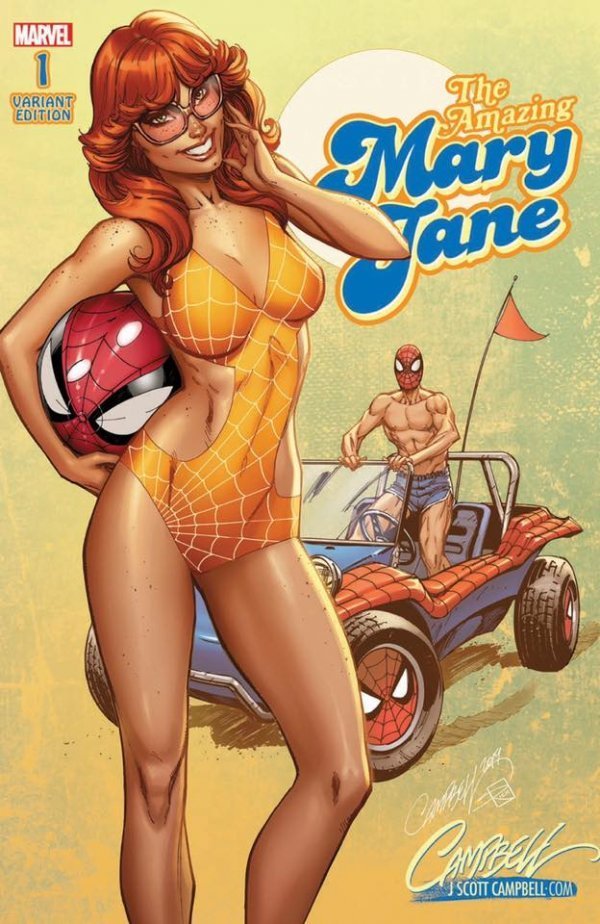
Previous Part
Next Part
Master Post
Last time I examined how MJ was repeating Peter’s ‘original sin’ in allowing Beck to not face justice. However I also raised the idea that the situation is different as Beck/his crew are arguably seeking redemption. Does that hold up to scrutiny? Well that’s what this instalment is all about.
At face value the crooks in the story certainly seem like they are seeking redemption.
Beck in particular is trying to make some form of amends and produce something good before he dies. It’s an opportunity he wants to extend to his fellow criminals (along with former felons).
Is shutting down this opportunity really something Mary Jane would do?
Yep.
Let’s ignore for a moment how MJ’s efforts to help her friend Lorraine failed and she was totally tricked by her. After all Lorraine might’ve been doing something illegal but she was the real victim in that situation.
Instead let’s look at some examples from Spider History where Peter encountered seemingly reforming criminals.
Black Cat
The most significant is perhaps that of the Black Cat; a.k.a. Felicia Hardy. Mary Jane doesn’t necessarily have an in depth knowledge of the ups and downs of Peter and Felicia’s relationship. But she would know that for a time Felicia was a criminal who reformed into a fellow crime fighter and then betrayed Peter by framing him for a crime. This all came to light in Spec #129.


Felicia reformed again after that and, after a very rough (somewhat violent) start, befriended MJ and became an ally to Peter. One of the key events that led to the thawing of Felicia’s relationship with the Parker family was her aiding a temporarily depowered Spidey. This occurred in ASM #342-343.
In these issues she helped the powerless Spidey defend innocents, protected him personally and bought time for him to regain his powers. These events entailed risking her life, enduring several injuries, losing her own powers (again temporarily) in the process. Specifically she had to single handedly battle a group of villains most of whom were beyond her weight class.
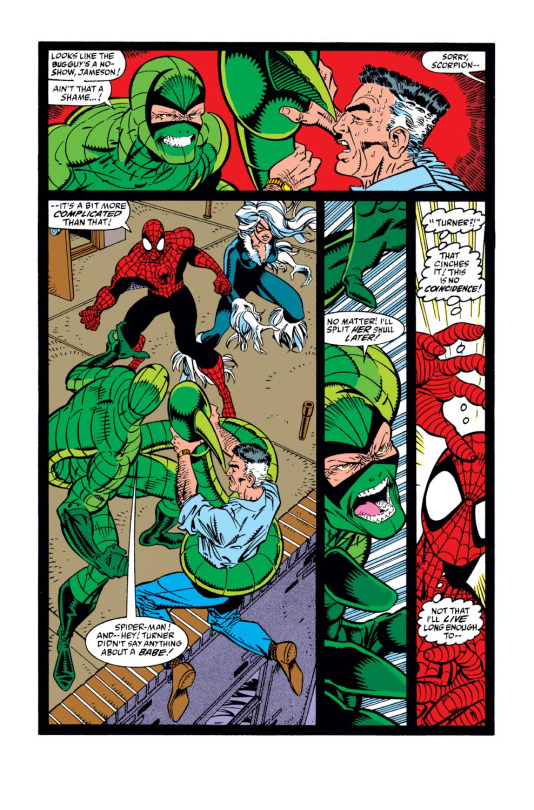
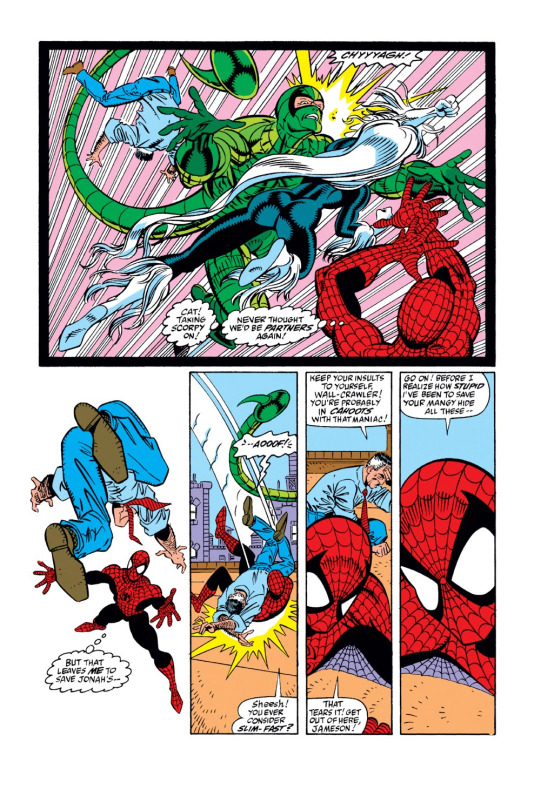

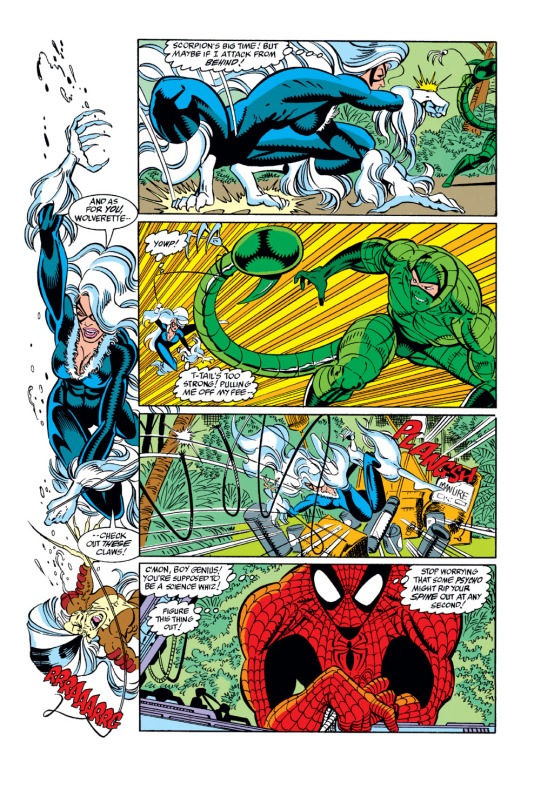


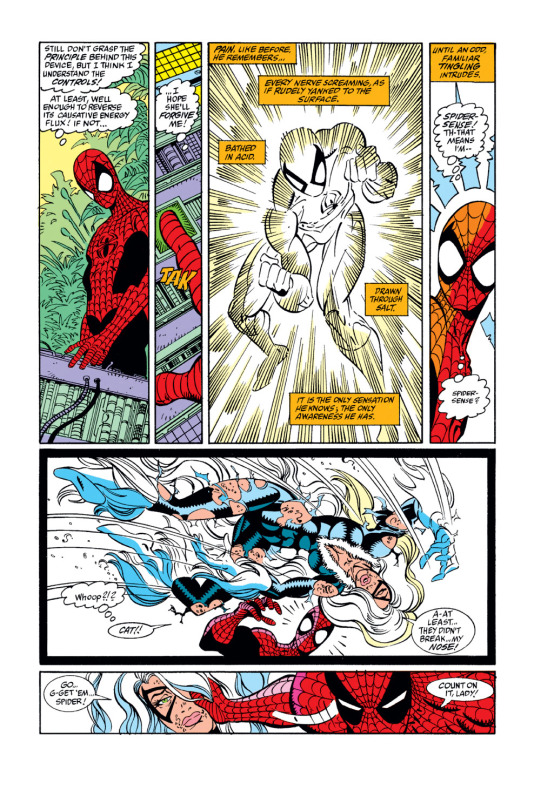
During and after these events Felicia showed signs of sincerely learning to love the Parkers’ friend Flash Thompson and wanting to start a new (costume free) chapter of her life with him. This was particularly notable because she had previously been dating Flash as a way to get back at Peter for marrying Mary Jane.


However, over consequent years though Felicia vacillated between anti-hero and outright criminal. Many people regard some of these takes out of character for Felicia post-OMD.
However, even before OMD Felicia was still vacillating in her moral alignment. Case in point, in Marvel Knights: Spider-Man #5, Felicia reveals she is working for the gang lord known as the Owl. Although she claims she has boundaries she won’t cross whilst in his employ, Peter is still unhappy with her new job.
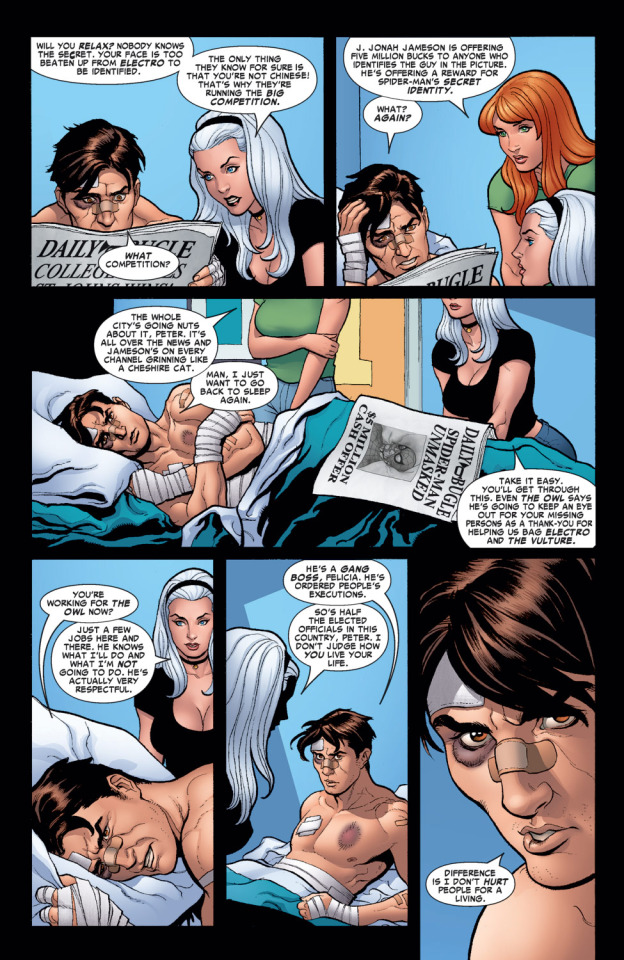
The facts are Felica was never consistently on the straight and narrow, a fact Peter and MJ were all too aware of.
Sandman
Perhaps a more apt example can be found in the case of the Sandman; a.k.a. Flint Marko. In Marvel Team-Up #138 Sandman was trying to go straight. In the course of the story he defended his neighbours from the Enforcers and actively saved Spider-Man’s life in the process. After the battle Spidey presumes there are outstanding warrants for Sandman’s arrest and tries to bring him in.
Sandman calmly explains he’s trying to reform and requests Spidey let him go. Spidey contemplates the idea because Sandman seems sincere but also considers that he’d be repeating the same mistake he made with Uncle Ben. As such he apologetically explains he can’t take the risk and prepares to apprehend Marko.
Unbeknownst to Spider-Man the last crook standing tosses a grenade his way. Sandman warns Spidey and intercepts the blast, both actions saving Peter’s life.
Spidey leaves the scene uncertain if Sandman survived and how to feel about his alleged attempts to reform.

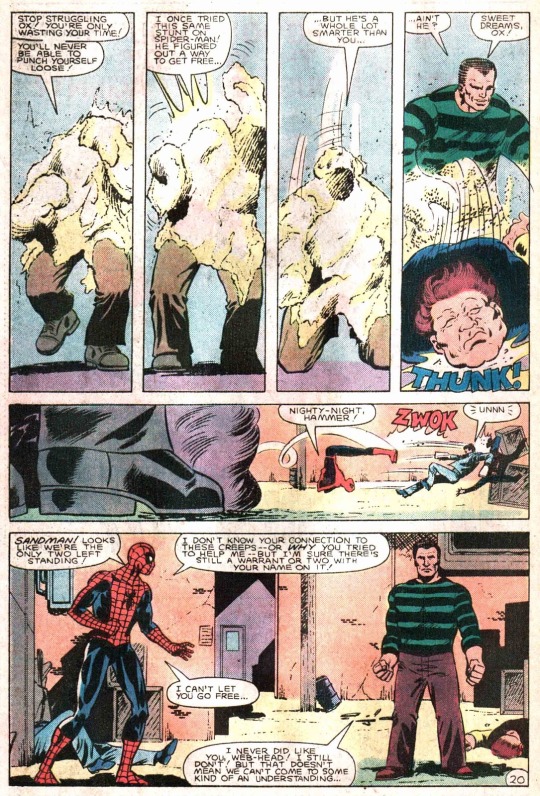

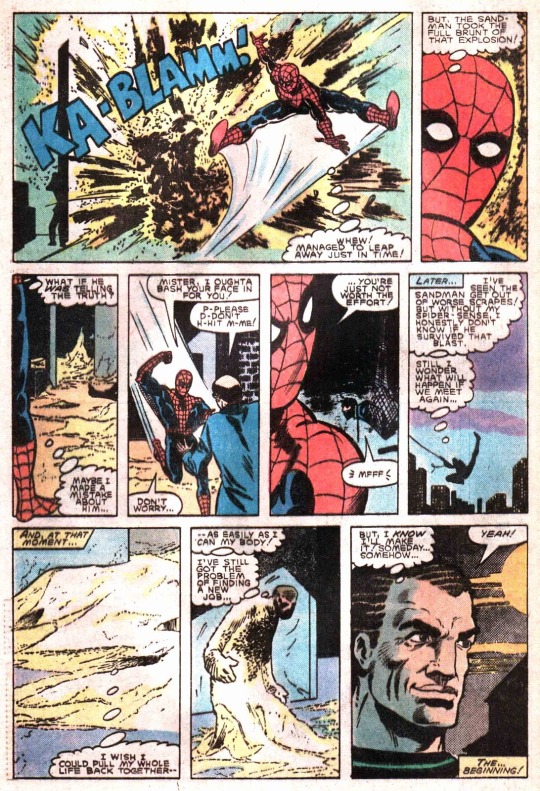
Spidey and Sandman encountered one another again in ASM #280-281. By chance Marko came across Spidey and mercenary Silver Sable at the mercy of several super villains. He once again saved Spidey’s life.


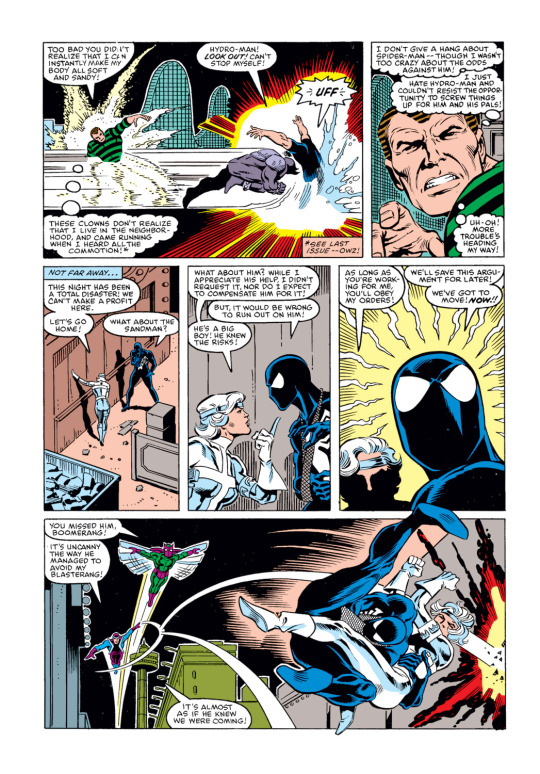


Soon after this Silver Sable officially hired him. It should be bared in mind that Sable has access to advanced weapons and highly trained soldiers. Perhaps more importantly though, as the ruler of Symkaria she was international political resources. As such it’s likely that Spidey figured Sandman’s outstanding crimes were either pardoned or he was working off his debt to society. And were he to hypothetically get out of line Sable had the resources to reign him in. Later Sandman would join the Avengers, which would be enough for most people to give him the benefit of the doubt, including Spidey or MJ.
Sandman’s alignment with both Silver Sable and the Avengers was a matter of public record. MJ would’ve heard about it just via osmosis; Avengers activities are normally big news after all. Even if she hadn’t, Peter would’ve talked about it because (as discussed in prior instalments) he usually clues her into his super hero life. Sandman being one of the few villains of his to have reformed? That’d not be a topic that’d go undiscussed.
However, for reasons we need not cover extensively, Sandman returned to crime. This too was a matter of public record and MJ was very aware of it since Sandman tussled with Spidey during this time. If nothing else she’d have known he was a villain again from his alliance with Doc Ock in ‘Ends of the Earth’.

Venom
Another Spidey villain who flirted with reform was of course Venom. There have been many ups and downs in Peter’s relationship with both the Venom symbiote itself and its most famous host Eddie Brock. For the purposes of this essay though we’re just going to be focussing upon events that transpired in the 1990s.
The first of these occurred in ASM #362 where Peter controversially formed an alliance with Venom to stop his sadistic spawn Carnage. Peter banked upon Venom’s sense of justice and desire to protect innocents as a way to gain his aid, but he also had to promise to allow Venom to walk free when their mission was complete.
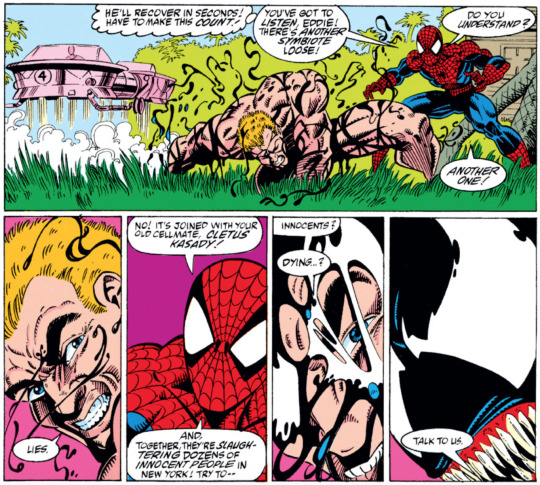
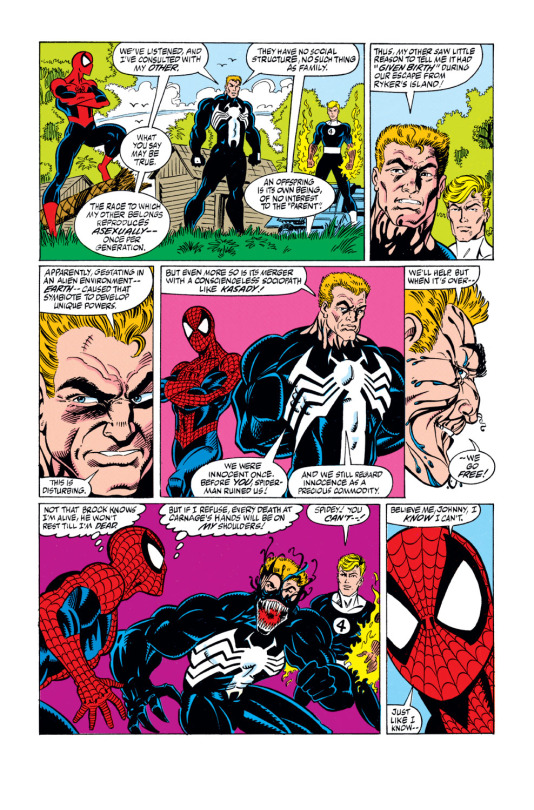

As it turned out though that was a risk Peter wasn’t willing to take. This was he had secretly plotted for the Fantastic Four to capture Venom once Carnage had been dealt with.

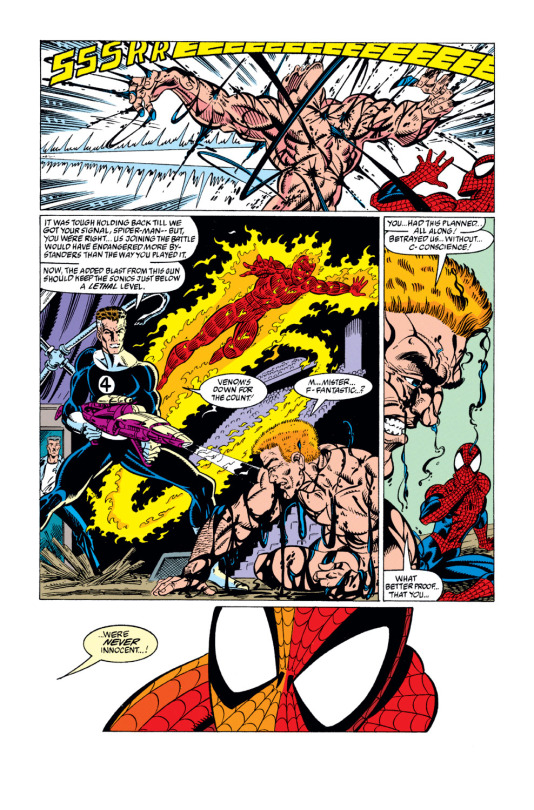

It’s worth remembering that Mary Jane had had a particularly bad experience when Venom first showed up and dealing with him was as much for her protection as for the world’s at large.
At the conclusion of their next encounter (ASM #375), Spidey and Venom made another arrangement. This controversial deal amounted to Spidey allowing Venom to walk free in exchange for Venom staying away from him. Peter’s rationale for this deal was born from a ‘live to fight another day’ mentality as he was exhausted and would’ve likely died had he continued to fight Venom. Mere moments after agreeing to this though Peter tried to tag Venom with a spider tracer.
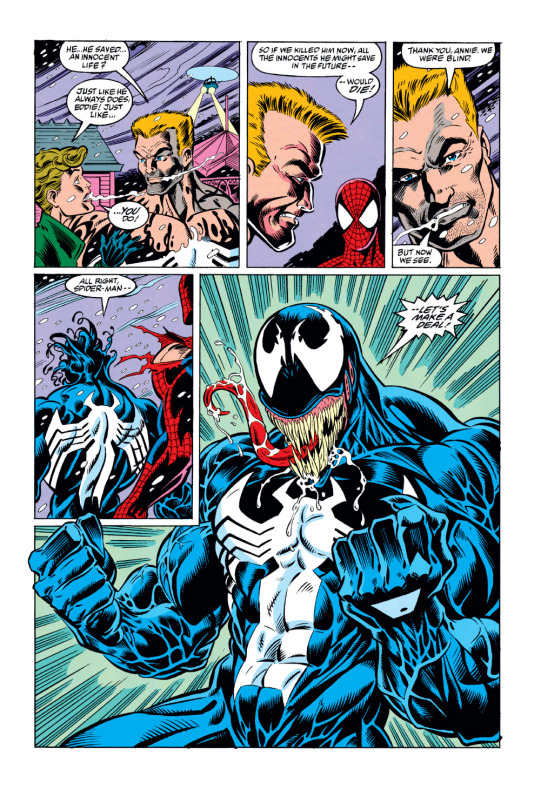

The very next story though (Venom: Lethal Protector) a recovered Peter tracks Venom down all the way to San Francisco and attempts to bring him in. Peter even acknowledges Venom being a disturbed killer and that his talk of ‘protecting innocents’ is bull.


During the course of the story Venom at times helped Spidey. But more importantly he refrained from killing Spidey (his life’s ambition) and asked for his help in saving countless innocents at the story’s climax. This was enough for Peter to temporarily help Brock again.
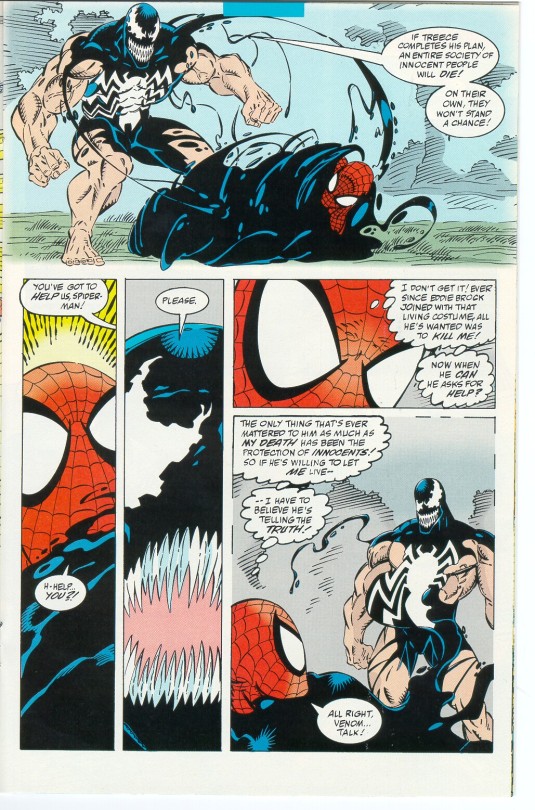
During the final battle Venom had no choice but to go through flames; fire being one of the things symbiotes are especially vulnerable to. Spidey is shocked by Venom’s selflessness, especially when Venom commented that Spidey himself would’ve done no different.
At the end of the story Peter tells MJ that he now believes in Venom’s change of heart, but qualifies that he’s returning to NYC in part because he can’t hunt Venom forever.
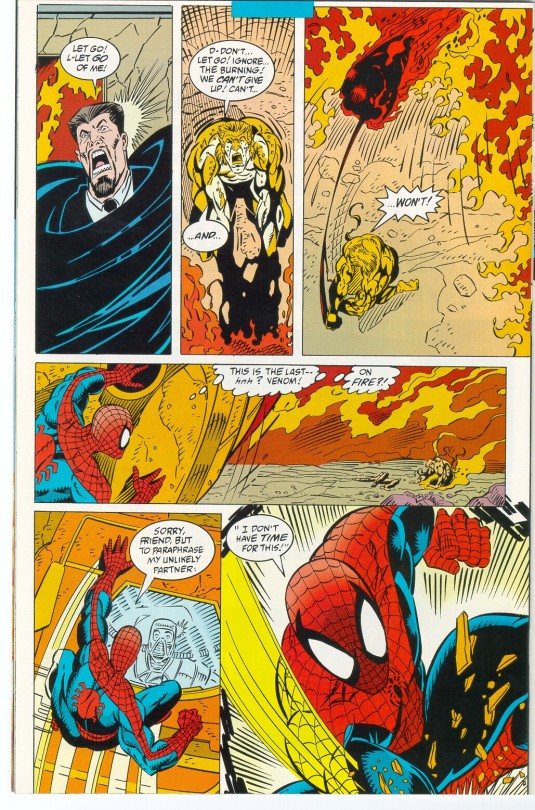


Essentially these experiences convinced Peter that Venom was sincere in his desire to turn over a new leaf, but that he should still be brought to justice nevertheless.
Inevitably Venom returned to his old ways and from there vacilated wildly in his moral alignment. As one of Peter’s most famous foes Venom’s activities were heavily covered in the news. Peter and MJ would’ve also kept an ear out and kept one another informed due to how personal Venom’s vendetta against them was and how dangerous he was. Basically MJ would’ve been aware Venom was rarely consistently on the side of the angels.
Boomerang
Next up we have a much more recent example, Spidey’s roommate Fred Myers, a.k.a. Boomerang. I would ask you to bear in mind that at the time of writing this I have only read up to ASM v5 #36 so events after that issue might further support or undermine my arguments.
One might argue that MJ giving Mysterio and his crew a chance at redemption is no different to Peter doing the same for Boomerang in very recent stories. However, there are very important nuances that differentiate the Peter/Fred situation to the MJ/Beck situation.*
The most important of these was that Myers got a full pardon for all his past crimes following H.Y.D.R.A.’s defeat in Secret Empire.
Boomerang committed crimes after his pardoning, notably robbing a museum. However, for reasons that baffled and concerned Spidey the mayor (Wilson Fisk, the ‘former’ Kingpin of Crime) allowed Myers to escape and even spun his crimes in such a way to exonerate him.

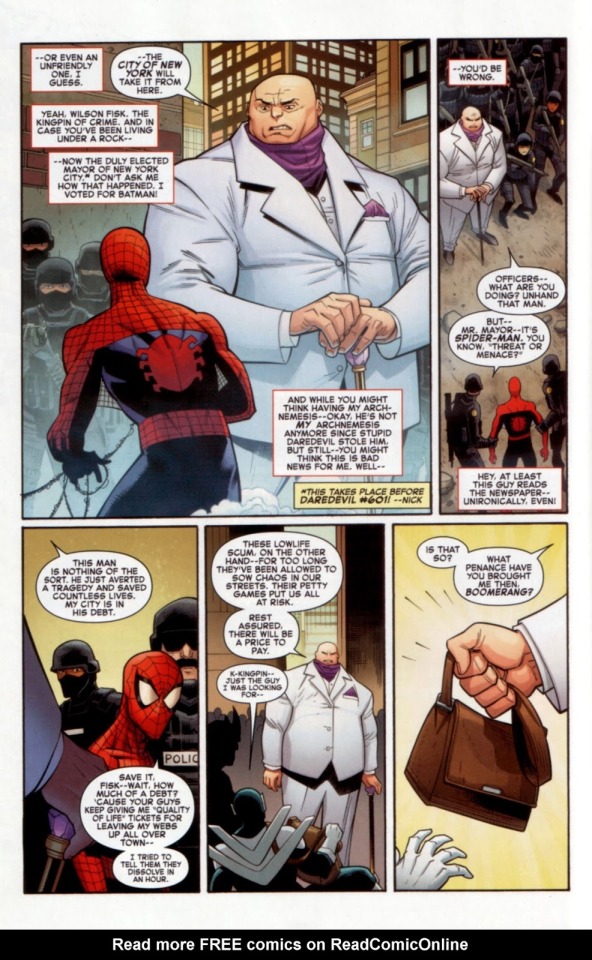
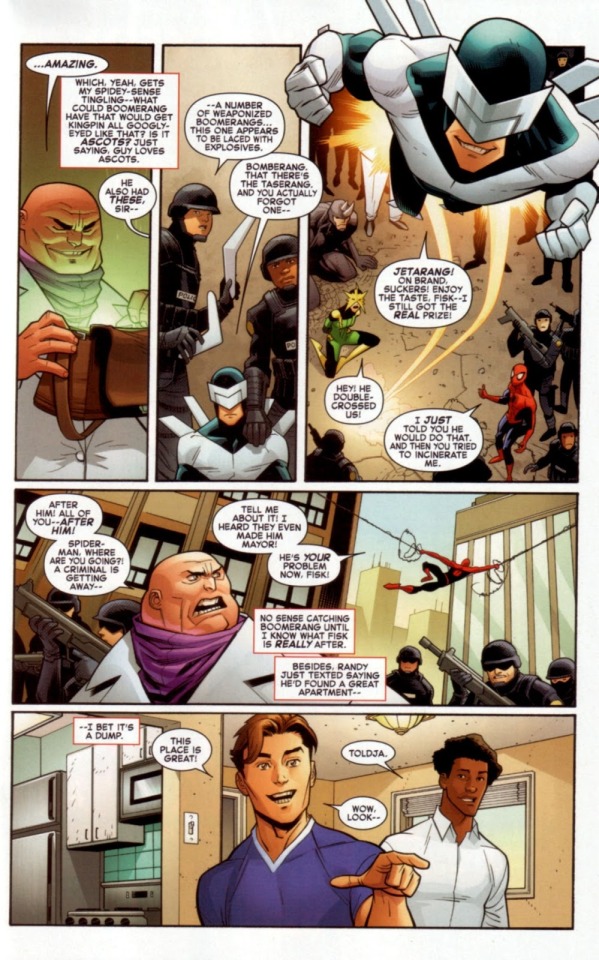
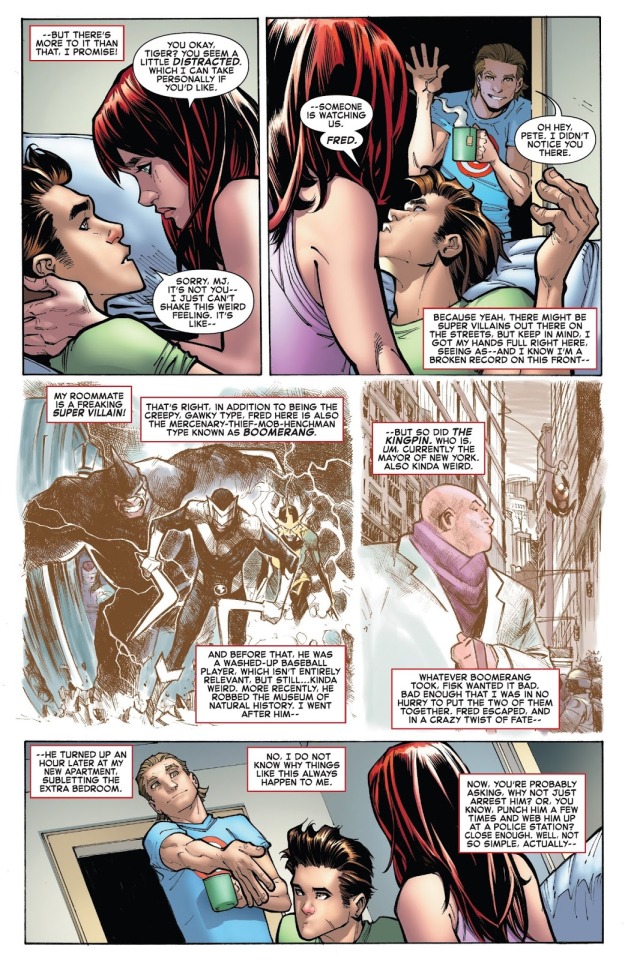

Spidey did let Boomerang initially escape but his rationale was purely because he didn’t know what Fisk wanted. This might seem contentious but it adds up when you think about it. If Fisk were the mayor then apprehending Boomerang would be tantamount to delivering him directly to Fisk, who is a far more powerful and dangerous threat. This logic would then extend to when Myers became Peter’s roommate.
Keep your friends close, and your enemies closer, especially when bringing them in could potentially help a much worse enemy. In the meantime Myers living with Peter could allow him to monitor him (using a spider tracer) and gather valuable information about what he (and Fisk) were up to.
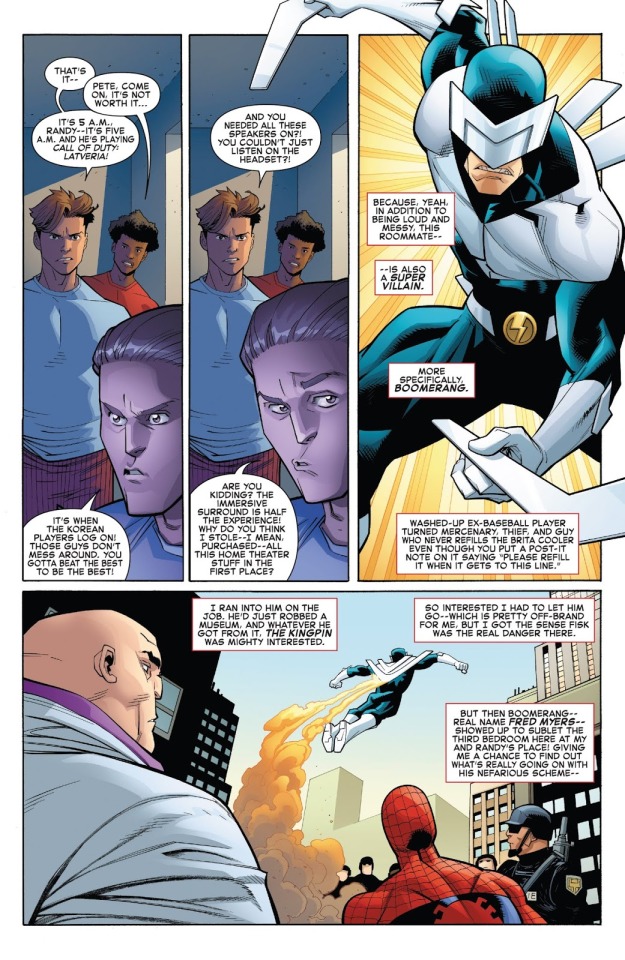

Peter remains sceptical and lays out his concerns directly to his other roommate Randy Robertson.

In ASM v5 #6-7 Boomerang took Peter (out of costume) to ‘The Bar-with-no-name’ (a hang out for super villains) for a trivia night. One might argue this situation echoes MJ being surrounded by super villains on her film set. But what distinguishes this situation from that one is the safety Peter’s abilities afford. He’s taken on groups of baddies before and most of the ones here are B-listers at best. More importantly though is that this presents an opportunity for Peter to gather valuable information, a fact that is framed as the reason he sticks around.

True, he also begins to enjoy himself but he also begins to empathise with them through spending time with them. Nevertheless he acknowledges that tomorrow he will be back to trying to catch them.
Peter’s reluctance to turn them in immediately can be viewed as a human flaw on his part. He empathises with the villains up to a point and begins to genuinely enjoy himself. Isn’t Mary Jane allowed to be flawed as well?
Sure she is, except MJ’s ‘flaw’ in AMJ is markedly worse than Peter’s here. In AMJ Mary Jane is complicit in several crimes via her silence and is allowing dangerous crooks with outstanding warrants for arrest to operate freely. Peter might be somewhat in the wrong for not turning them in then and there, but he at least intends on apprehending them eventually and in the interim uses the opportunity to gain information that will over all help combat more crimes. In theory he could simply put a call through to the cops or the Avengers that night. MJ on the other hand seemingly has no plan to apprehend the criminals she’s working with at all.
As the story progresses the Kingpin puts a bounty on Boomerang’s head prompting the assembled crooks to turn on him and Peter. The pair are forced to fight their way to freedom, during the course of which Boomerang provides some cover for Pete and a weapon to defend himself with.

At a critical point in the battle Boomerang selflessly takes a nasty hit meant for Peter; which leaves the latter shocked and baffled.
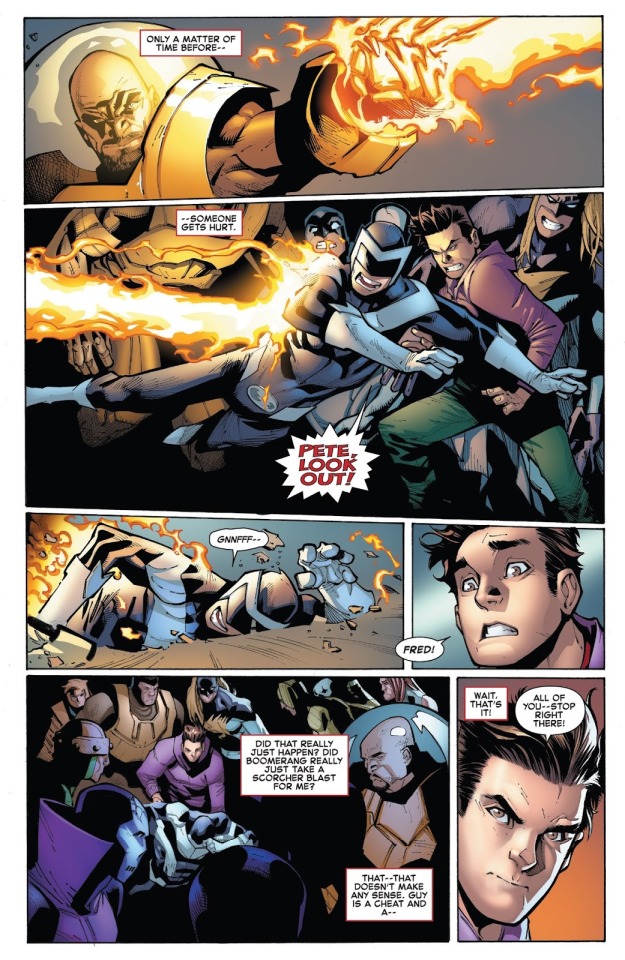
After Pete buys a little time Fred follows this up with an exploding boomerang and shoves Peter to safety.

Fred reveals he refrained from using his explosive earlier because he genuinely loved the bar; further exemplifying his sincere desire for companionship. In spite of this Peter still doesn’t regard Fred as redeemed nor reformed. Fred then confesses that he created robot duplicates of his old gang members (known to readers as the Superior Foes) due to missing their companionship and recognizing that his betrayals of them left him lonely. Moving in with Peter and Randy seemed like a second chance to him and Peter, in spite of his better judgment decides to give Fred that second chance.
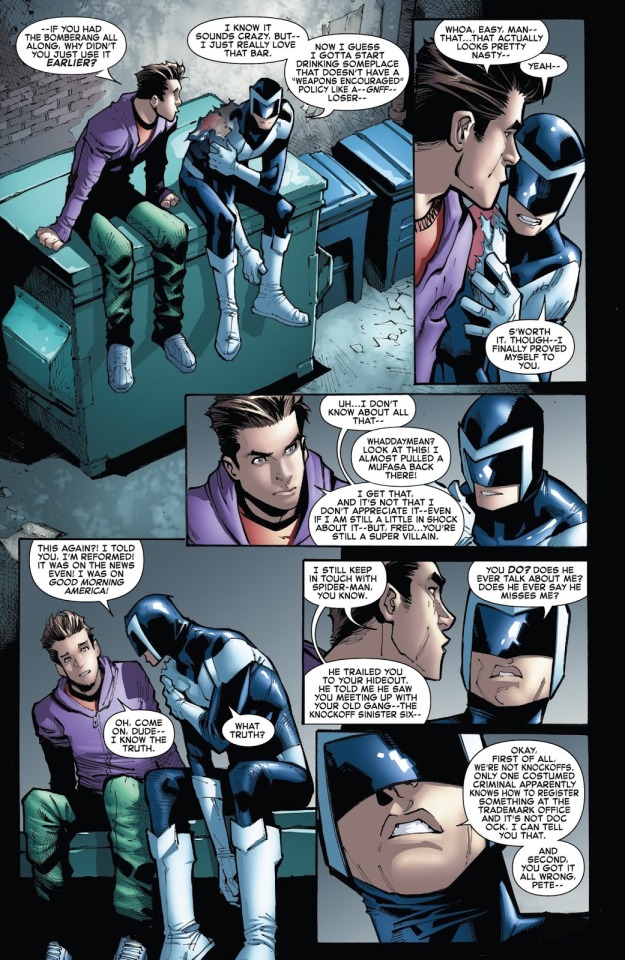
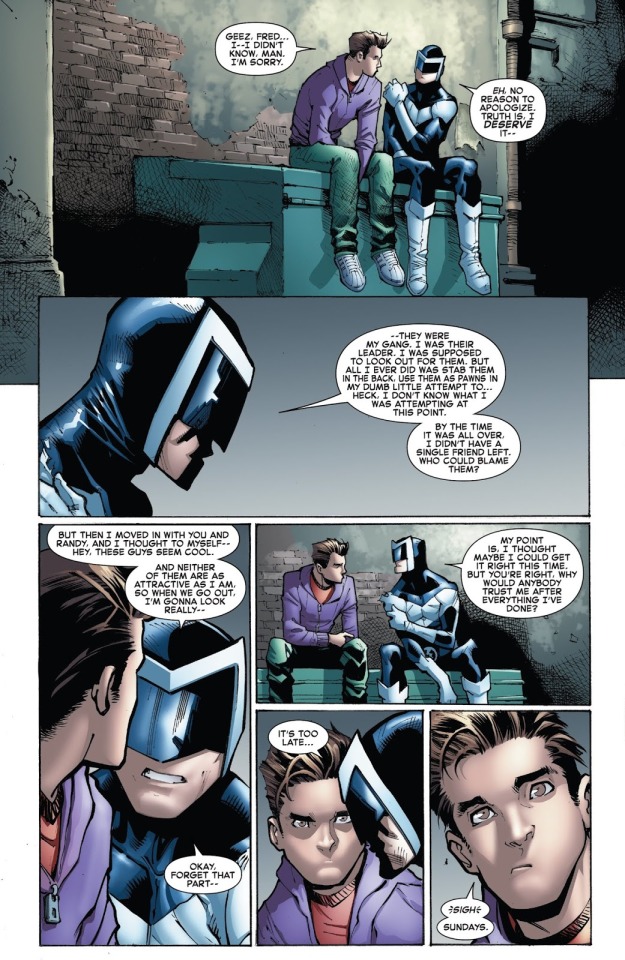
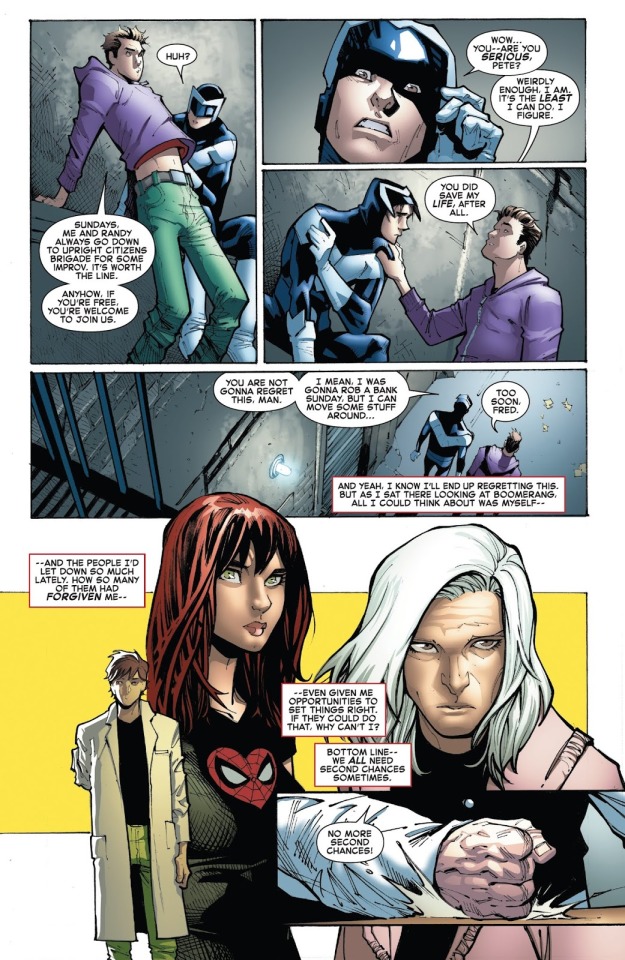
What differentiates this from what MJ is doing (besides Boomerang not being half as bad as Mysterio and not backed up by a whole crew of crooks) is that Peter is giving Fred this chance after he has actively demonstrated redeeming qualities.
Fred might be lying about his desire for companionship (just Mysterio might be lying to MJ about everything else) but Fred didn’t and couldn’t have faked saving Peter’s life at risk to himself.
Actions speak louder than words and in AMJ all Mary Jane has is the word of a notorious deceiver that neither he nor his crew are up to no good and will behave themselves…you know apart from all the crimes he already fessed up to like identity theft.
In fact all of the instances listed above involve the criminals actively demonstrating redeeming behaviour. Typically these have taken the form of risking their lives to protect innocents and/or their enemy Spider-Man.**
However Peter has also not trusted them blindly.
In Felicia’s case she lost her powers so her ability to commit crimes was reduced and she had saved his life and been a crime fighter enough that it’s likely he felt she deserved yet another chance.*** In Sandman’s case he began working for someone who could arrange for his legal situation to be straightened out and had the means to keep him under control too. In Venom’s case Peter recognized his change for the better but never fully trusted him, merely letting him go because he was physically unable to find him. And in Fred’s case turning him over the authorities could prove worse than temporarily allowing him to walk free whilst Peter kept a close eye on him.
Mary Jane was either a witness to these incidents or at least would’ve likely heard about them from Peter. As I demonstrated in parts 3-5 Peter shares most of his experiences with Mary Jane. Additionally, her own sense of justice and responsibility is clearly shaped by Peter’s (to some extent).
So in the case of a guy she has no means or monitoring, can’t be sure she’s keeping an eye on because he’s a master illusionist (who literally has highly convincing holograms/robot duplicates), has no reliable means of restraining and has never demonstrated any redeeming actions to her she should NOT be trusting him to go straight; let alone a whole crew of villains…
…But if you are reeaaaaaaaaaalllly still unconvinced…let’s talk about the Black Fox.
The Black Fox
The Black Fox is an elderly gentlemen thief/cat burglar that Peter had an encounter with back in ASM #265. The story ended with Peter learning that the Black Fox’s latest scheme was merely his last after which he hoped to retire and be with his family. In response to this Peter helped the Fox escape, although he recovered the stolen goods first.
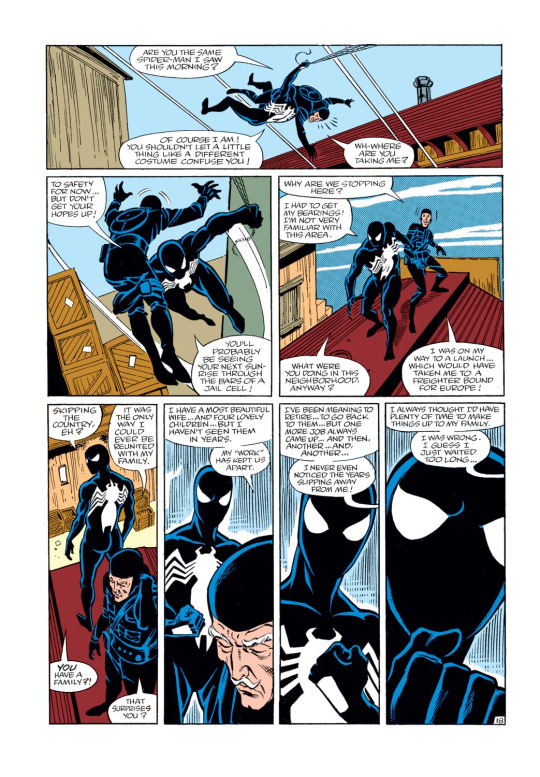
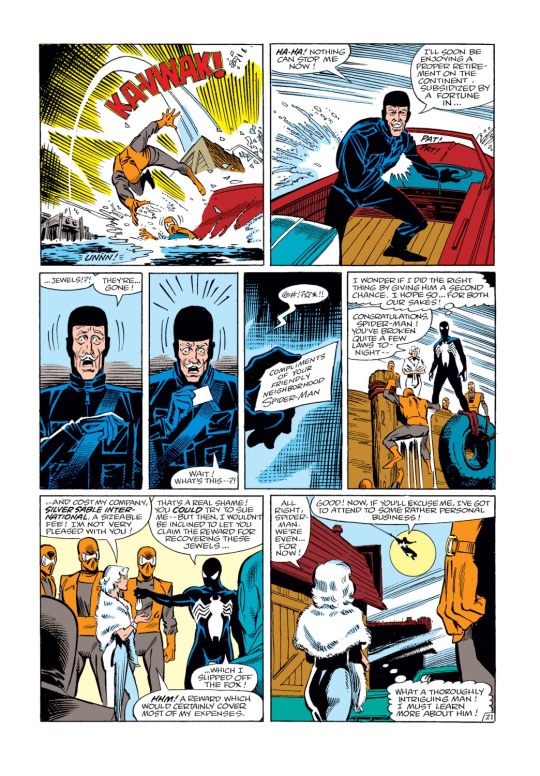
Years later in ASM #305 Spidey again encountered the Fox who in fact hadn’t retired. And yet Spidey once again let him go again out of pity.

In ASM #349 he once more found the Fox in mid-crime and let him go again. Afterwards Peter confessed to MJ that this cycle of behaviour with the Fox was deeply upsetting him.
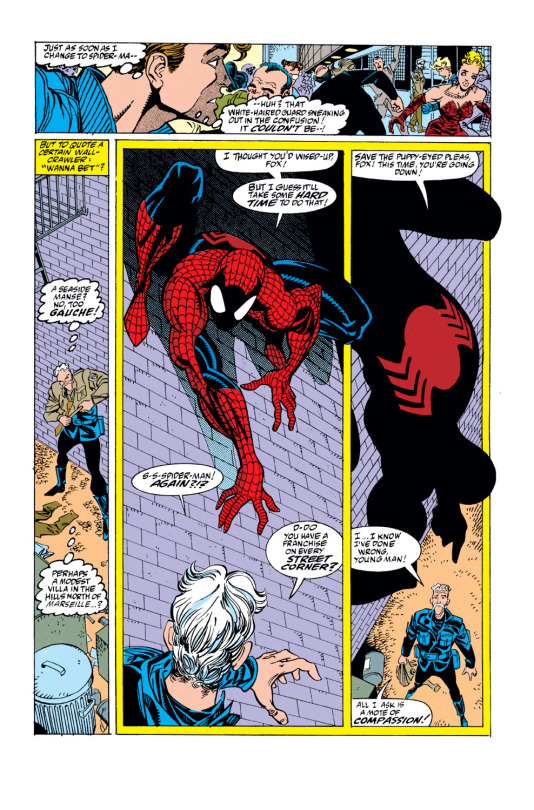


Spidey allowing the Fox to go free once again actually resulted in a major incident involving Doctor Doom of all people!
After a concussion induced conversation with Uncle Ben (a creation of his subconscious) Peter realized his leniency on the Fox was born from a general sympathy for older men (who naturally reminded him of his uncle).

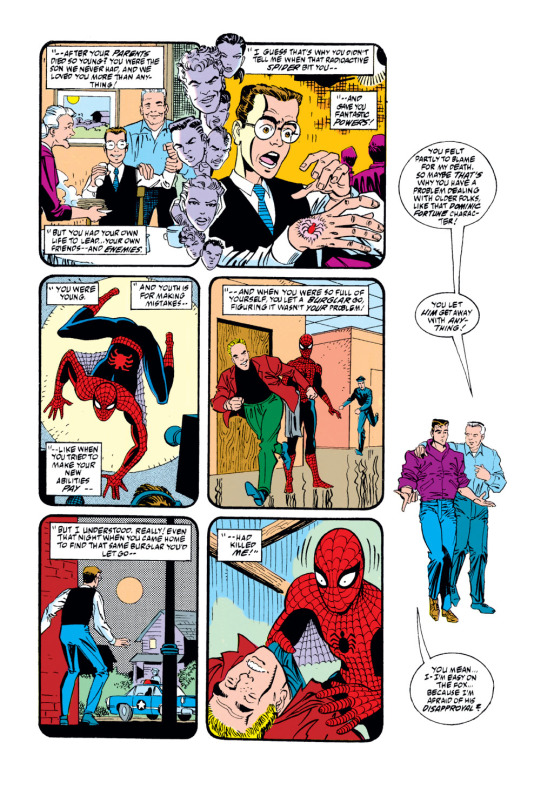

Having resolved his issues Peter was then capable of bringing the Fox to justice.
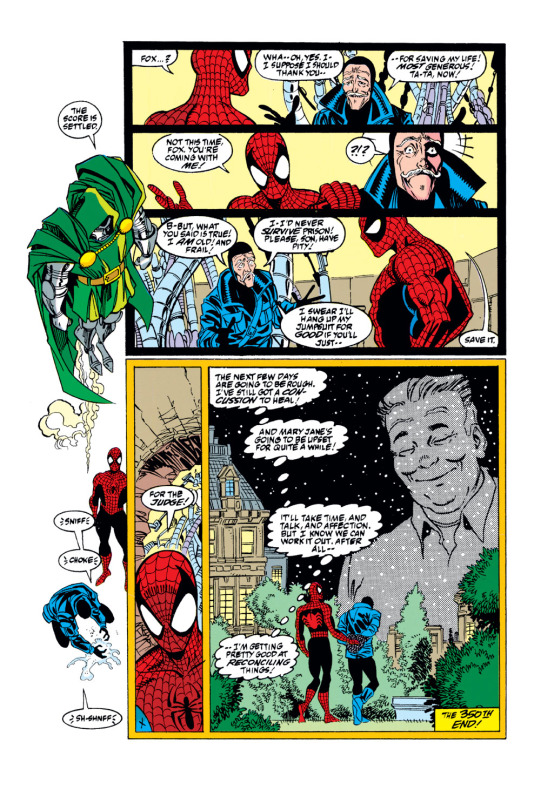
Mary Jane was obviously aware of this adventure as Peter actively talked to her about her hang ups with the Fox during the course of it, and it would be baffling to believe that he wouldn’t have then told her he brought him in eventually.
If MJ is aware of how Peter’s morality played out here, the repercussions of his leniency on the Fox and the internal strife caused by letting him go there is no way in Hell she’d make the same mistakes with Mysterio. She doesn’t even have the same excuse as there is no huge trauma from her youth inclining her to be unreasonably sympathetic to Beck or his crew.
The Black Fox is honestly nowhere near as dangerous, manipulative or as unethical as Mysterio. If the Black Fox deserves to face justice for his far less damaging crimes, then Mysterio and his cohorts ethically shouldn’t be given a free pass by MJ or even the chance to do something good before they’ve paid their debts to society either.
The situation with the Fox proves the dangers of simply giving criminals the benefit of the doubt blindly, whilst every other reforming or reformed criminal has either proven themselves somehow or done so within some kind of controlled environment.
That wasn’t the case for the Fox, and it certainly isn’t the case for Mysterio from MJ’s point of view.
Finally let’s talk about one very significant instance that some might bring up to counter all I’ve said above.
Let’s talk about Mary Jane’s father.
Phillip Watson
You will recall in the last instalment I examined how MJ ultimately turned him into the cops for his crimes for the greater good and even at the risk of her sister’s freedom.
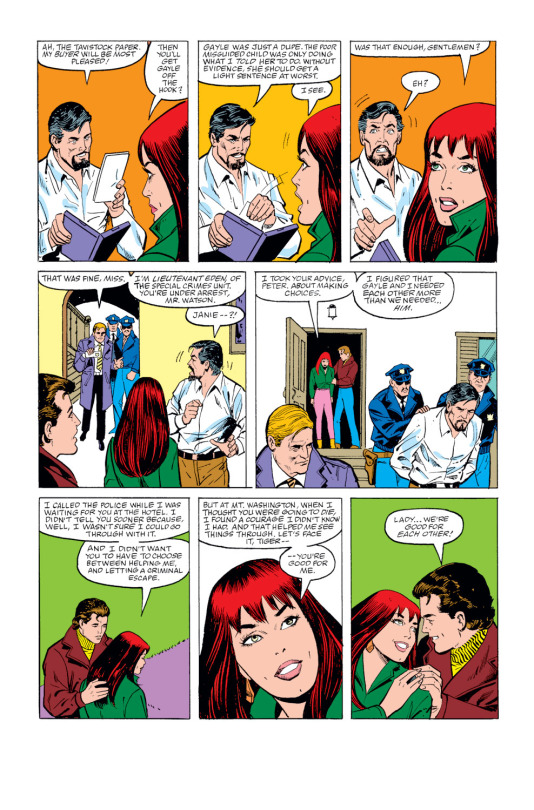
Well in the Clone Saga they met again. MJ felt compelled to settle some unfinished family business and thus confronted her sister and then (separately) her father.
For some context not only had her father committed a crime, not only had he exploited MJ’s sister Gayle and thereby caused her to wind up arrested, but in her childhood he had routinely verbally abused both girls along with their mother and physically assaulted Gayle once.

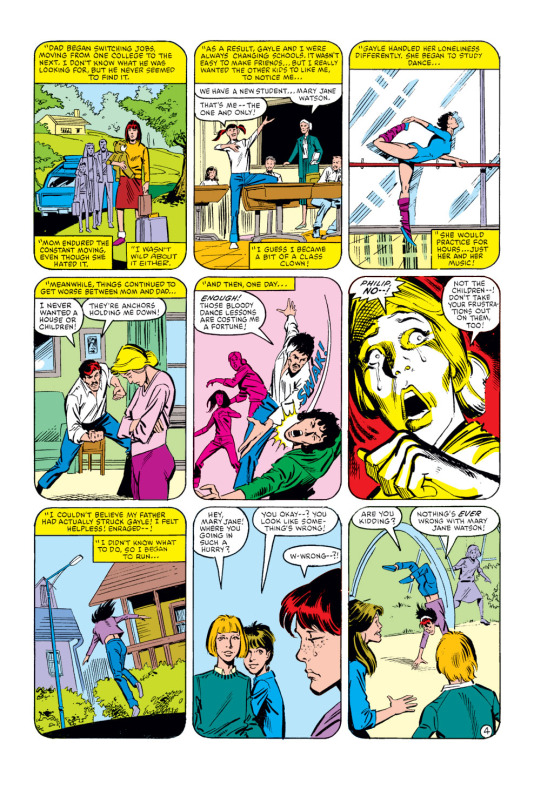

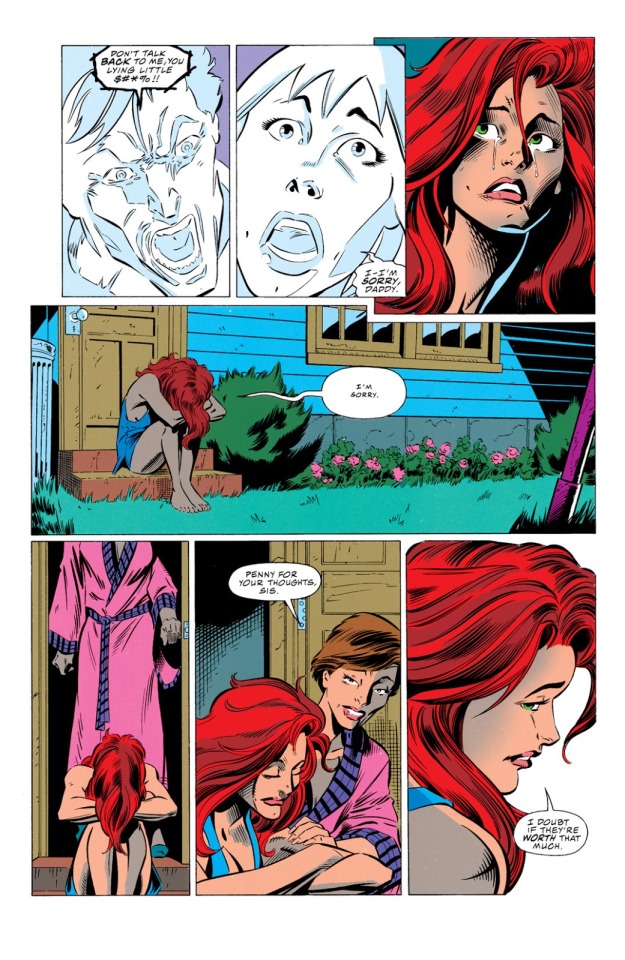
MJ had major beef with her father over this and hadn’t let it go by the time she met up with him again in ASM #292. In said issue she even referred to him as ‘Phillip’ rather than ‘Dad’, father, etc.

It could be speculated that her decision to turn him in might’ve been influenced by this bad baggage. Although she was also uncertain of that due to her attachment to him and possibly perceived guilt over her parents’ break up.


In Spec #219 MJ nervously confronts her father. After making some small talk she is enraged when she sees he’s kept a picture of her mother. She feels that after how he treated her he doesn’t have that right.
However her surprises her when he breaks down in tears admitting he’s ashamed of how he acted and that he’s haunted by how he hurt and abandoned MJ’s mother. MJ connects with this, drawing a comparison with how she abandoned her sister Gayle in her time of need. She even states this to her father.



Spec #119
She manages to emotionally connect with her father and even forgive him. Whilst it’s only a start she feels complete and like in some way she has her family back, which fills her with joy.
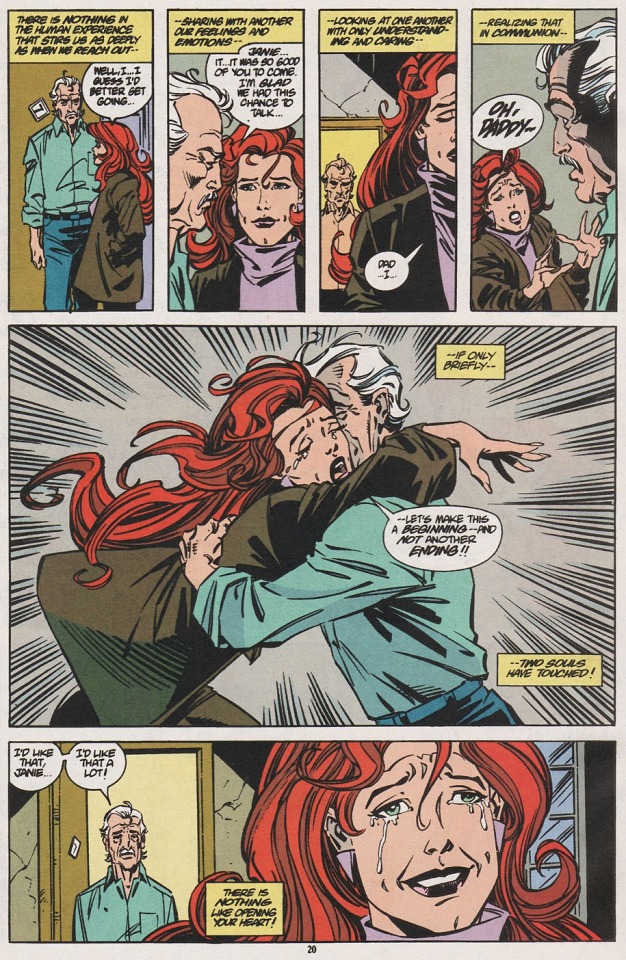
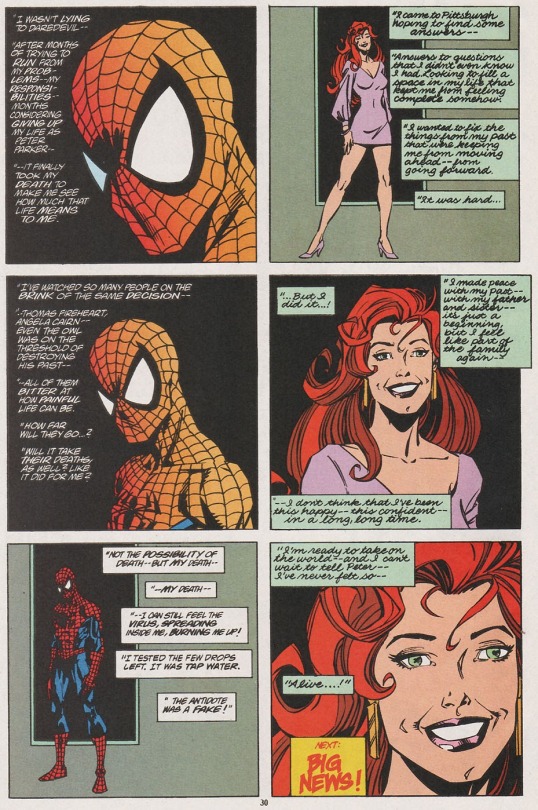
You could take this situation and make a strong case for MJ being willing to forgive Mysterio right?
She did it for someone who had been a criminal and personally hurt her and her family in a very serious way. So why wouldn’t she extend that so someone who had also harmed her and her family. Harmed them in ways that might be argued to be not as bad as her father?
The problem with such a comparison is that it’s not exactly a fair equivalency at all.
To begin with, though he had been a criminal, MJ’s father had served his time and faced the legal repercussions for his crimes. MJ had no hint that he was in the midst of committing any other crimes when she reunited with him, nor that he’d be likely to go on to commit any crimes.
Even the crimes h had committed were far less numerous and far less bad than those in Mysterio’s criminal career. MJ’s father for instance never drugged and sexually violated a teenaged girl or attempted murder. And given his age, health, intelligence and history the chances of him committing further crimes if
Now there was a lot of emotional baggage and pain MJ carried in relation to her father but as evidenced in ASM #292 her feelings towards him were not black and white. A part of her felt some combination of guilt and loyalty towards him. Furthermore, when we learned of MJ’s past in ASM #259, she also revealed that following their separation, she tried to write to her father a few times.
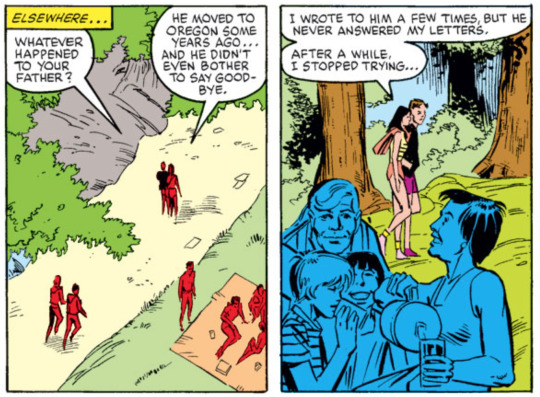
Why would MJ as a tween/teen do such a thing? Why try to connect with someone who abused her and her loved ones, someone she intellectually knew was bad for everyone concerned?
The sad truth is such things are often happen in real life in similar situations. It is born from an immensely strong natural and innate need within all human beings to form bonds with our parental figures.****
MJ’s earliest (and therefore some of her most formative) memories involve her father, about how (in her mind at least) she loved him and he loved her. How he was the one man in her life who was supposed to always love her no matter what.
So even if he wound up far from that ideal, there is still a yearning within MJ on some level for that. Hence her attempts to reconnect with him both in ASM #259 and Spec #219, along with her uncertainty in ASM #292.
And that’s the single most critical difference between this situation and the one with Beck.
Beck is not her father.
She hasn’t got any positive emotional attachment to him (imagined or otherwise) nor is there a potent need within her to have one.
From her point of view he is simply a very bad and very dangerous person who has done horrible things, has hurt her and hurt the people she cares about. Someone who is doing something very bad right now and who stands a very strong chance of consequently doing further bad things that might harm other people (including herself and her loved ones).
Not to mention her father was not a slick professional liar like Mysterio was. MJ has no reason to believe his emotional breakdown is a performance whereas with Beck it’s extremely possible that he is just acting.
There is one other aspect of this example to explore though. Namely how MJ saw herself and her father as kindred spirits. Is it possible she sees herself and Beck in a similar light and thereby affords him the benefit of the doubt? Well, that’s a topic for another time.
Suffice it to say that all the experiences we’ve looked at would give Mary Jane a belief in redemption…but not a blind faith. For her there would have to be particular factors in play to justify such faith in the first place and neither Beck nor his crew fit those factors whatsoever.
Thus MJ would not give them a chance, at least not under these circumstances. In fact, in Mysterio’s case, she wouldn’t give him a chance under pretty much any circumstance. This is because, however much sympathy MJ might hold for the death of a fellow human being, her sympathy would only go so far for Mysterio. It would most certainly not stretch to believing him capable of redemption.
That’s a subject more for next time though.
*There are certain obvious physical differences in these two dynamics, but we’ll discuss those another time. Right now we’re strictly looking at MJ giving Beck and his crew a chance to make good.
**One could argue in saving Peter’s life he owes them at least the chance to prove they can turn over a new leaf.
***Of course we could just say his old feelings for her were affecting his judgement, but obviously that wouldn’t be a factor for MJ and Beck.
****There are countless examples of this within real life and fiction, a particularly poignant example can be found in the Fresh Prince of Bel Air. Will Smith’s character is presented the chance to reconnect with his father who abandoned him as a child and ultimately takes up the opportunity. When his father abandons him again he tries to shrug it off but his anger and grief is immense.
P.S. I shouldn’t have to spell this out but I will. Beck claims in AMJ #1 that he is trying to do something good by making his movie and giving fellow crooks a chance to help him. Despite the issue’s framing this absolutely would not count as a good deed. Not to MJ and according to just common sense.
Making a movie or a piece of art is not inherently a good thing. Even if it was as good deeds go it’s not the most meaningful or helpful. Certainly not the most actively helpful thing Beck personally could do.
It certainly doesn’t constitute a good deed when you consider the subject matter of the movie is himself. This is just a criminal’s vanity project which he is making with the aid of other criminals. Nothing more.
It is hardly equivalent to protecting innocent people or risking your life as many of the above characters did.
Previous Part
Next Part
Master Post
#Leah Williams#Amazing Mary Jane#Mysterio#Quentin Beck#mary jane watson#Mary Jane Watson Parker#MJ Watson#mjwatsonedit#spider-man#peter parker#Black Cat#Felicia Hardy#Sandman#William Baker#flint marko
18 notes
·
View notes
Text
Voiced by: Ai Nonaka (JP), Lauren Landa (EN), Marga López (Spain) A veteran and morally ambiguous magical girl, she first appears as a foe to Madoka and Sayaka, serving as a "pseudo-villain" for a few episodes. Her view of a magical girl's duties are ruthlessly utilitarian; for example, on her first encounter with Sayaka, she suggests allowing a familiar to feed on humans and mature into a witch so as to ultimately gain a grief seed from slaying it. She wields a halberd whose shaft can split into chained-together segments, giving her weapon dangerous flexibility and reach. Adorkable: In the drama CD with her and Mami which takes place before she became jaded. Anti-Hero: After her Heel–Face Turn, she becomes mainly a Knight in Sour Armor. Anti-Villain: Initially appears as a dangerous antagonist and a cynical Social Darwinist who lets people die just to harvest more Grief Seeds for herself. However, it turns out that she isn't outright malicious, and is merely a broken girl: her selfishness is a result of her selfless wish backfiring spectacularly, and she later warms up to Sayaka and others after realizing the truth about magical girls, to the point that she isn't antagonistic at all in Rebellion. Arc Villain: Serves as the main villainous focus for a few episodes until her Heel–Face Turn, but mostly as the catalyst to demonstrate The Plan and intention of the real villain, Kyubey. Back from the Dead: In the Grand Finale. Since she died fighting a witch, Madoka is able to revive her with her wish. Bare Your Midriff: A lot of art work — both official and fan — implies she's wearing a belly shirt underneath her jacket. Berserk Button: She threatens to kill Sayaka for wasting food. Better to Die than Be Killed: After finding out the whole Awful Truth and unable to save Sayaka, Kyoko felt she had two choices: destroy her soul gem in a final attack to put Sayaka out of her misery and die together, or win the fight the usual way and still become a witch sooner or later, be killed by a magical girl and die alone. Considering her past, guess which one she picked? Big Damn Heroes: Gen Urobuchi loves to play with this trope. In Kyoko's case, Homura saves Sayaka from her and then she saves Sayaka from Elsa Maria. Then she saves Sayaka from a very pissed-off Homura. She tops it off by protecting Madoka and Homura's escape from Oktavia... by going out with a bang. Big Eater: She's always eating something and it's not Played for Laughs, as there is a Freudian Excuse for it. Blade on a Stick: Uses a spear as her signature weapon. Blood Knight: Unlike the other girls she enjoys hunting witches mainly for her own selfish purposes. Broken Bird: She used to be a lot like Sayaka, a "hero of justice" but then her dad freaked out and killed their family. Is there any surprise she is now so cynical and selfish? Byronic Heroine: A good person with a dark past and a lot of angst who engages in hedonistic behavior; yep. Calling Your Attacks: She never does this in the anime, but in the third drama CD, Mami insists on calling her Doppelgänger Attack "Rossa Fantasma" - literally "Red Phantom". Kyoko says it once during battle, but then breaks out laughing afterwards because she can't take it seriously. Catch Phrase: "You want some?" Chekhov's Gunman: Appears in the title and credits sequences before appearing in the series. It's also implied that she's the magical girl that Kyubey and Mami talk about in Episode 3, who made a wish for someone else. This is confirmed in the third drama CD. Clingy Jealous Girl: Becomes this to Mami in The Different Story. After their separation, Kyoko tried to bait Mami to fight her twice and got frustrated both times by her refusal. The irony is that this jealousy is the result of Mami taking Sayaka as her partner. Curtains Match the Window: Red hair and eyes. Cute Little Fangs: She has one and it makes her look like the predator she talks about. (Also cute.) Cynicism Catalyst: She made a shortsighted wish to bring followers to her father's congregation. When he realized what was going on, he killed his family. After this, she decided to work for herself and only herself. Dark Action Girl: She's selfish, brutal, and not at all heroic. This changes some after her Heel–Face Turn. Dark and Troubled Past: Her father was a priest, but he was excommunicated for "heresy" and the Sakura family fell in poverty as he couldn't support them anymore. Kyoko used her wish to get more followers for him...but when he found out it was just magic and not his ideas and words, he went crazy and killed himself and his entire family, leaving Kyoko as the only survivor. Darker and Edgier: Than the other main characters who think of themselves as traditional 'love and justice' magical girls. Dark Magical Girl: Her time in the show is all about pitting herself and her beliefs against Sayaka, who sees herself and her beliefs as a traditional magical girl. As per the trope, she has a Heel–Face Turn and develops a soft spot for Sayaka, who reminds her of her ideals. Death Equals Redemption: Part of the reason of her Heel–Face Turn is the realization that magical girls are essentially liches, and that she might as well do something to remedy this situation. Culminating in her Heroic Sacrifice to give the bewitched Sayaka a Mercy Kill. She even gets her final moment of clarity, where she realizes that she has always wanted to protect someone. Defrosting Ice Queen: Introduced as cold and selfish, but reveals a slightly warmer personality later as she grows fond of Sayaka. Depower: The third drama CD reveals that Kyoko could originally create illusory copies of herself, but she lost this power when her family died. Despair Event Horizon: Played with. As the sole survivor of a Pater Familicide committed by her father she became bitter and jaded but her soul gem did not corrupt so she held onto a bright outlook. When Kyubey lets slip the Awful Truth, she shows more and more humanity. Potentially played straight in the PSP game if Homura defeats Oktavia before she has a chance to save what is left of Sayaka, thus removing the very last trace of hope and idealism she had left, and triggering her transformation into Ophelia. Died Happily Ever After: Implied in the anime to be her eventual fate, following Madoka's wish. Doppelgänger Attack: The third drama CD reveals that Kyoko's original power was to create decoys of herself. She lost this power when her family died. Dying Moment of Awesome: She kills Octavia in a Heroic Sacrifice which is also a Together in Death attempt. Elegant Gothic Lolita: Her fighting outfit looks a little like this with a Showgirl Skirt thrown in. Evil Redhead: Initially, she is an antagonist and her hair color is much darker than pink-haired Madoka. Expy: Red hair? Check. A passionate and cruel personality to go with it? Check. Introduced a third into the series and as being above the protagonists in skill and power? Check. Lives for battle? Check. Antagonizes the blue-haired girl? Check. Has Tsundere tendencies? Check. Abrasive attitude caused by a parent who went mad and committed suicide? Check. Are we describing Kyoko or Asuka Langley Soryu?note Her first name and long ponytail also bring Yoko Littner, Asuka's Spiritual Antithesis, to mind. Face Death with Dignity: Her last moment is her praying to her God. Fallen Heroine: She was sort of a Church Militant and she acknowledged how stupid heroism is but not even she can help feeling a little sympathy for Sayaka's broken state, leading her to a Heel–Face Turn. Fiery Redhead: As her red hair indicates, she's abrasive and hotheaded. Foil: To Homura, a fact not made clear until Rebellion. Kyoko acts selfish, but it's mainly to drive people away from the fate she suffered, and she regains her humanity through her interactions with Sayaka and Madoka. Homura on the other hand, while fighting for the greater good, is ultimately driven by selfish reasons, and the hostility she received from the other girls in other timelines has left her jaded and cynical. Freudian Excuse: Her love of food comes from her family constantly starving after her father was excommunicated for "heresy" and barely having enough to eat; a scene in the manga shows Kyoko getting punished by her mother for wasting food. Her selfish and Jerkass nature comes from the fact that her wish led to her maddened dad killing the whole Sakura family except for her. Hair Decorations: Her ponytail is tied up with a large black bow (and a hairpin, as shown in Episode 9). Heel–Face Revolving Door: From an Adorkable rookie magical girl to an amoral Psycho for Hire to a defrosted Knight in Sour Armor. Heel–Face Turn: Cements this with a near-Precision Bitch Strike as soon as Kyubey lets slip the Awful Truth. She then dedicates herself to preventing her friends from suffering Sayaka's fate. Heroes Gone Fishing: Homura once meets up with Kyoko while she's playing a dancing game in an arcade. Heroes Want Redheads: Inverted; she seems to be after Sayaka, but not the other way around. Heroic Sacrifice: She does a Mercy Kill on Sayaka so she won't have to die alone. In The Different Story, she uses Oktavia's grief seed to cleanse Mami's soul gem, but this leaves her without another one to use on herself, and she dies while fighting another witch later. Hero of Another Story: She was a magical girl for a long time. Her start up until meeting Madoka could be its own story. Hidden Depths: She reveals to Madoka in Episode 9 she used to love stories where love would triumph. This is hinted at when Kyoko tells Sayaka about her Dark and Troubled Past; losing her family left her jaded, but she didn't fall into the Despair Event Horizon and she kept on fighting. "I Know You're in There Somewhere" Fight: She tries to do this alongside Madoka in a desperate attempt to save Sayaka after she turns into a Witch. It fails and Kyoko has to kill Sayaka along with herself. Impaled with Extreme Prejudice: In the manga, during her fight with Oktavia von Seckendorff. Ironic Echo: When she first encountered Oktavia (Sayaka's witch form), she was rescued by Homura because she was carrying Sayaka's lifeless corpse and had no way to defend herself. When she refused to drop Sayaka's corpse, Homura calls her a hindrance. During their futile attempt to bring Sayaka back from being a witch, a very injured Kyoko leaves an unconscious Madoka to Homura, before stating that they should leave because Homura would not be able to fight with a hindrance like herself, before making her Heroic Sacrifice. Irony: The daughter of a religious man, who battled witches in the dark, is labeled as a witch by her own father. To make it worse, instead of her father burning her at the stake, he burns himself, Kyoko's mother and younger sister together with their church, leaving Kyoko the last of her family. It's All About Me: This is what she claims to be her philosophy; that a magical girl should only use her powers to benefit herself. However, she says this to Sayaka because she thinks she would benefit from that philosophy, and then she tries to help Sayaka against a witch. Jade-Colored Glasses: There was a time she was actually a lot like Sayaka and she wished to be a "hero of justice", but had her optimistic worldview shattered when her father killed her whole family and then himself after finding out people only listened to his preachings because of the wish she'd made. Japanese Christian: Her father was a priest. She seemed to have been observant when she was younger but there's little evidence that she still is. She does appeal to God as she makes her Heroic Sacrifice, but whether this is out of faith or desperation or some combination thereof is ambiguous. She carries a bag of apples during her explanation of her backstory and attempt to persuade Sayaka to her way of thinking. Japanese Delinquents: She skips school, picks fights with those who enter her territory, wears somewhat inappropriate clothing for her age, and lives off of stolen food. And true to the major character archetype of this trope, she turns out to be nicer than she acts. Japanese Pronouns: Uses "atashi" for herself, which is odd considering her Darwinist lifestyle and masculine vocabulary. Jerkass: Initially, she cares about nothing more than killing her foes and leaving people to die in order to benefit herself. Jerk with a Heart of Gold: Her backstory doesn't justify her horrible treatment of Sayaka before the Awful Truth happened. However, her later interactions with Sayaka and Madoka show that, Jerkass as she is, Kyoko is still somewhat redeemable. Kleptomaniac Hero: Implied that she stole most, if not all, of the food she was eating. Knight in Sour Armor: After being reminded of her ideals by Sayaka she became this; renewed idealism but still bitter. Knight of Cerebus: There's a reason why they waited until after Mami's death scene to introduce her and why she originally didn't appear with the other core four in promotional materials. The Lad-ette: Magical girls are known for their femininity. Kyoko is not. Lady in Red: Her magical girl outfit is red and she has hedonistic tendencies. The Lady's Favour: Inverted in The Different Story. Kyoko goes off to fight Oktavia and leaves her ribbon with Mami, promising her to return to get it back. Lady Swears-a-Lot: By Japanese-standards, her vocabulary is filthy and at best is inappropriately masculine. Laughably Evil: There are no comic relief characters in Madoka, and definitely not Kyoko, but try not to chuckle a bit as she nonchalantly stuffs her face with food or plays a Bland-Name Product Dance Dance Revolution clone as the events of the series unfold. Leitmotif: "Anima mala" ("Evil soul"). Letting Her Hair Down: Does this just before sacrificing herself for Sayaka. Lost Food Grievance: Do not waste food in Kyoko's presence if you value your life. She'll Neck Lift you. Magic Knight: Mainly a melee fighter, but her main element is "enchantment" and she can occasionally use illusionary powers. Master of Illusion: Used to be capable of illusions as her magical girl power before the Pater Familicide incident. Meaningful Name: 'Kyouko' means 'apricot' (this ties in to Momo, the name of her sister, meaning 'peach'), which symbolizes strength achieved through struggles with adversity. 'Sakura' is the cherry blossom, which represents the transcience of life. Mercy Kill: Gives one to Sayaka that doubles as a Taking You with Me. Minor Living Alone: Kyoko lives in her apartment complex alone with no parental supervision due to her father murdering her mother, younger sister, and then himself in a murder-suicide. Neck Lift: Performs one on Sayaka when she throws her apple to the ground without eating it. Nice Girl: The Different Story and the PSP game show that she used to be this back when she first started out as a magical girl, being a very nice and polite girl who wanted to save the world from Witches and had undying respect for Mami, just like Sayaka did. But her father's increasingly abusive behavior after he found out the Awful Truth and eventual Pater Familicide left her jaded and resulted in her becoming far more cynical, amoral and selfish to the point where her and Mami's friendship ended because her philosophy developed into the complete opposite of Mami's. No Body Left Behind: Implied to be her ultimate fate eventually, due to Madoka's wish. Nominal Hero: At the start, while she's a magical girl who fights witches and may be loyal to both her teammates and the mission, she cares far more about killing witches, gaining grief seeds, and letting familiars kill people so they can become witches with grief seeds, than she does about protecting civilians. Not So Different: From Sayaka. She criticizes Sayaka for fighting for someone else's sake, but ends up sacrificing herself to take out Oktavia to make sure Sayaka/Oktavia won't die alone. This is lampshaded when she tells Madoka that Sayaka made her remember the reason she became a magical girl. Oral Fixation: Always has something in her mouth. Pater Familicide: In her backstory, her father killed her entire family save her before killing himself. Pimped-Out Dress: Her magical girl outfit is bloodred to symbolize her aggressive nature and the blood that was spilled as a consequence of her wish, as well. It is also adorned with the symbol of her father's church. Preacher's Kid: She was an angelic Church Militant before things went bad. When we meet her, she's well over on the cynical side. Psycho for Hire: Initially she kills witches for their grief seeds and Kyubey has her on call. Psychosomatic Superpower Outage: She's been unable to use her Master of Illusion powers ever since the Pater Familicide incident. It's implied this was because of the trauma she experienced. As shown in side materials, in a few of the alternate timelines she eventually gets them back. A Pupil Of Mine Until She Turned To Evil: She used to be Mami's apprentice just like Madoka and Sayaka, until the Pater Familicide happened and Kyoko decided to be selfish with her magic. Rapunzel Hair: Her messy hair grows past her back. Instead of the 'wealth' or 'high status' associations, it's more likely because she doesn't bother cutting it. Red and Black and Evil All Over: Initially she is a villain and her magical girl outfit is red with a bit of black. Redemption Equals Death: Sayaka's influence on Kyoko leads her to perform a Mercy Kill that takes both of of them out. Red Eyes, Take Warning: Her eyes are red and she is the first indication that some magical girls are outright evil. Red Oni, Blue Oni The red to Sayaka's blue. She's more feral and hedonistic and they are color coded. Also the red to Mami's blue in the past and in The Different Story because she was more reckless and less precise than her mentor. Say My Name: She yells "SAYAKAAAA!!!" when Sayaka becomes a witch. Selective Obliviousness: A common theme is how Kyouko says many things... while not actually doing them. She says she's going to kill Sayaka... but is content (at first) to only beat her up before walking away. She talks trash about Mami and her beliefs... but as other content showed, she at first came back to Mitakihara to try to reconcile with her, before learning about her death. She even made a grave for her. She comments on how normal people are essentially just food... but never hurts Madoka and doesn't stop her from going to Sayaka. She even encourages Madoka that she's done nothing wrong and that being a magical girl isn't something to envy. She talks about how magic is only meant to be used for herself... but her wish was used for someone else, and even after that she uses magic for Sayaka and Madoka's sake, repeatedly. Serious Business: Nearly strangles Sayaka because she threw an apple on the ground. Played for Drama; see Freudian Excuse above. She's Got Legs: Comes with wearing short shorts. Ship Tease: Implied to have a one-sided crush on Sayaka. Sir Not-Appearing-in-This-Trailer: Didn't appear in early promotional materials, likely because of her darker nature. Sour Outside, Sad Inside: At first, she seems to be a mean, selfish girl who believes that magical girls should use their powers for their own purposes. As the series progresses, it's revealed why she acts this way: Her family fell into destitution after her preacher father was excommunicated and when he found out that his followers increased and came back was due to Kyoko's magical girl wish and not from people actually believing in him, he killed his family and himself and only she survived. It is only when she learns about the Awful Truths of being a magical girl and when she saves Sayaka from Homura that she starts to get over her sourness, which culminates in her performing a Mercy Kill to witch!Sayaka and sacrificing herself so Sayaka wouldn't be alone. Spell My Name with an "S": "Kyoko" versus "Kyouko". Both are officially endorsed, with the anime materials using Kyoko and manga materials using Kyouko. The Social Darwinist: She compares the fight against witches to the food chain: Witches and their familiars prey on weak humans, while Magical Girls are the apex predators and prey on Witches. Familiars don't drop grief seeds, so she sees no point in killing them before they kill enough people to become a witch themselves. She also applies this to Magical Girls themselves: weaker ones should yield their territory over to the stronger ones or die. She seems to have abandoned this philosophy after learning the true nature of Magical Girls. Stopped Caring: She was very idealistic when she started out, wanting to be a hero and save people from witches. After the Pater Familicide, she's now perfectly fine with letting people get killed by Familiars if it means more Grief Seeds. Meeting Sayaka reminds her of her old ideals and eventually gets her to start caring again. Stupid Sacrifice: The only thing Kyoko accomplished by throwing her soul gem to Oktavia was forcing Homura to fight Walpurgisnacht all by herself. Suicide Attack: She kills Oktavia with one. Super Drowning Skills: According to the 4th drama CD, she can't swim. Sweet Polly Oliver: In a gag image Kyoko decides to disguise herself as a boy in order to become closer to Sayaka. Sweet Tooth: She's constantly munching on sweets, even during battle. Together in Death: With Sayaka via Suicide Attack. Token Evil Teammate: Initially, prior to her Heel–Face Turn, she was a nasty magical girl. Kind of like a mercenary. Tomboy: She's even more tomboyish than Sayaka with her aggressive personality and masculine manner of speaking, but despite that, she still refers to herself with a feminine pronoun. Tomboy and Girly Girl: Tomboy to Mami's and Sayaka's girly girl, having a much rougher speech pattern and being more aggressive and masculine than both of them. Tomboyish Ponytail: Although her hairstyle should be more feminine than Sayaka's, it also emphasizes her nature as a rough Action Girl and looks quite unkempt. It also contrasts quite a bit with the preppy but cute Mitakihara school uniform, which she wears in Rebellion and the best ending of Portable. Tomboy with a Girly Streak: Downplayed; aside from using the feminine pronoun "atashi", her speech patterns are very rough and masculine, and when it comes down to it she's not very girly at all. In comparison, Sayaka is quite a bit more feminine than she is. Took a Level in Kindness: After starting as a bitch, Sayaka's and Madoka's suffering soften her up little by little. This culminates in Episode 9 with her bonding with Madoka, then sacrificing herself to save Madoka from a bewitched Sayaka, and putting Sayaka out of her misery. Tsundere: She comes off as aggressive and bitchy, but there's a warmer personality buried under. These tendencies are more prevalent towards Sayaka and Mami in The Different Story, since she obviously cares about them but refuses to express it openly. Tsurime Eyes: Befitting her harsh and confident nature. Unwitting Instigator of Doom: Had Kyoko not picked fights needlessly with Sayaka, Madoka wouldn't have snapped and thrown Sayaka's soul gem away, thus The Reveal would have happened later, or not and all — and thus, Sayaka wouldn't've begun her Start of Darkness either. Used to Be a Sweet Kid: A Daddy's Girl who made a Selfless Wish and heroically fought witches, who later became a Nominal Hero and Blood Knight. Variable-Length Chain: Her spear can segment into parts separated by chains. Her spear's shaft length also changes between scenes. We Used to Be Friends: The third drama CD shows that she and Mami knew each other when they were younger and were friends and partners in fighting witches, until the Pater Familicide happened and Kyoko decided to be more selfish with her magic. What Have I Become?: Not even she could stay indifferent to the Awful Truth but she takes becoming a lich better than Sayaka. Whip Sword: Her spear is capable of splitting into chains, but it also appears to be able to curve in a whip-like fashion. Who Wears Short Shorts?: In her civilian garb. It's another tomboyish contrast with her fellow feminine magical girls. Wrong Genre Savvy: Tries to start an "I Know You're in There Somewhere" Fight to transform Sayaka back from her witch state. Explicitly lampshades it ("It'd be like one of those stories where love and courage triumph over all"). Considering the tone of the series, it's not surprising that it doesn't work. Zettai Ryouiki: She's sporting a Grade B in her magical girl outfit and her school uniform.
0 notes